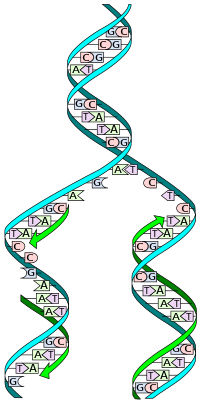
Back تضاعف الحمض النووي الريبوزي منقوص الأكسجين Arabic डी एन ए कय नकल AWA DNT replikasiyası Azerbaijani Репликация (ДНК-ның икеләтә артыуы) Bashkir Рэплікацыя ДНК Byelorussian Репликация на ДНК Bulgarian ডিএনএ অনুলিপন Bengali/Bangla Replikacija DNK BS Replicació de l'ADN Catalan دووھێندبوونی دی ئێن ئەی CKB

In molecular biology,[1][2][3] DNA replication is the biological process of producing two identical replicas of DNA from one original DNA molecule.[4] DNA replication occurs in all living organisms acting as the most essential part of biological inheritance. This is essential for cell division during growth and repair of damaged tissues, while it also ensures that each of the new cells receives its own copy of the DNA.[5] The cell possesses the distinctive property of division, which makes replication of DNA essential.
DNA is made up of a double helix of two complementary strands. The double helix describes the appearance of a double-stranded DNA which is thus composed of two linear strands that run opposite to each other and twist together to form.[6] During replication, these strands are separated. Each strand of the original DNA molecule then serves as a template for the production of its counterpart, a process referred to as semiconservative replication. As a result of semi-conservative replication, the new helix will be composed of an original DNA strand as well as a newly synthesized strand.[7] Cellular proofreading and error-checking mechanisms ensure near perfect fidelity for DNA replication.[8][9]
In a cell, DNA replication begins at specific locations, or origins of replication,[10] in the genome[11] which contains the genetic material of an organism.[12] Unwinding of DNA at the origin and synthesis of new strands, accommodated by an enzyme known as helicase, results in replication forks growing bi-directionally from the origin. A number of proteins are associated with the replication fork to help in the initiation and continuation of DNA synthesis. Most prominently, DNA polymerase synthesizes the new strands by adding nucleotides that complement each (template) strand. DNA replication occurs during the S-stage of interphase.[13]
DNA replication (DNA amplification) can also be performed in vitro (artificially, outside a cell).[14] DNA polymerases isolated from cells and artificial DNA primers can be used to start DNA synthesis at known sequences in a template DNA molecule. Polymerase chain reaction (PCR), ligase chain reaction (LCR), and transcription-mediated amplification (TMA) are examples. In March 2021, researchers reported evidence suggesting that a preliminary form of transfer RNA, a necessary component of translation, the biological synthesis of new proteins in accordance with the genetic code, could have been a replicator molecule itself in the very early development of life, or abiogenesis.[15][16]
- ^ O'Donnell M, Langston L, Stillman B (July 2013). "Principles and concepts of DNA replication in bacteria, archaea, and eukarya". Cold Spring Harbor Perspectives in Biology. 5 (7): a010108. doi:10.1101/cshperspect.a010108. PMC 3685895. PMID 23818497.
- ^ Prioleau MN, MacAlpine DM (August 2016). "DNA replication origins-where do we begin?". Genes & Development. 30 (15): 1683–1697. doi:10.1101/gad.285114.116. PMC 5002974. PMID 27542827.
- ^ Dewar JM, Walter JC (August 2017). "Mechanisms of DNA replication termination". Nature Reviews. Molecular Cell Biology. 18 (8): 507–516. doi:10.1038/nrm.2017.42. PMC 6386472. PMID 28537574.
- ^ Sabhadiya A (2022-03-01). "What Is DNA Replication And Its Steps?". Retrieved 2023-08-04.
- ^ "GENETICS / DNA REPLICATION (BASIC) – Pathwayz". pathwayz.org. Retrieved 2020-12-10.
- ^ "double helix". Learn Science at Scitable. Nature Education. Retrieved 2020-12-10.
- ^ Pray LA (2008). "Semi-Conservative DNA Replication; Meselson and Stahl". Nature Education. 1 (1): 98.
- ^ Imperfect DNA replication results in mutations. Berg JM, Tymoczko JL, Stryer L, Clarke ND (2002). "Chapter 27: DNA Replication, Recombination, and Repair". Biochemistry. W.H. Freeman and Company. ISBN 0-7167-3051-0. Archived from the original on 2020-03-26. Retrieved 2019-08-09.
- ^ Lodish H, Berk A, Zipursky SL, et al. (2000). "DNA Replication, Repair, and Recombination". Molecular Cell Biology (4th ed.). WH Freeman. ISBN 0-7167-3136-3.
- ^ Hu Y, Stillman B (February 2023). "Origins of DNA replication in eukaryotes". Molecular Cell. 83 (3): 352–372. doi:10.1016/j.molcel.2022.12.024. PMC 9898300. PMID 36640769.
- ^ Berg JM, Tymoczko JL, Stryer L, Clarke ND (2002). "Chapter 27, Section 4: DNA Replication of Both Strands Proceeds Rapidly from Specific Start Sites". Biochemistry. W.H. Freeman and Company. ISBN 0-7167-3051-0. Archived from the original on 2020-03-26. Retrieved 2019-08-09.
- ^ "What is a genome?". yourgenome. Retrieved 2020-12-10.
- ^ Chagin, Vadim O.; Stear, Jeffrey H.; Cardoso, M. Cristina (April 2010). "Organization of DNA replication". Cold Spring Harbor Perspectives in Biology. 2 (4): a000737. doi:10.1101/cshperspect.a000737. ISSN 1943-0264. PMC 2845211. PMID 20452942.
- ^ Jarillo J, Ibarra B, Cao-García FJ (2021). "DNA replication: In vitro single-molecule manipulation data analysis and models". Computational and Structural Biotechnology Journal. 19: 3765–3778. doi:10.1016/j.csbj.2021.06.032. PMC 8267548. PMID 34285777.
- ^ Kühnlein A, Lanzmich SA, Braun D (March 2021). "tRNA sequences can assemble into a replicator". eLife. 10: e63431. doi:10.7554/eLife.63431. PMC 7924937. PMID 33648631.
- ^ Maximilian L (3 April 2021). "Solving the Chicken-and-the-Egg Problem – "A Step Closer to the Reconstruction of the Origin of Life"". SciTechDaily. Retrieved 3 April 2021.